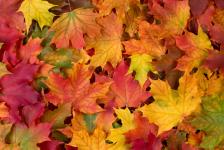What Are Stem-and-Leaf Plots?
How do you make stem-and-leaf plots? Why might you want to? How are they related to the stems and leaves that fall from trees?
Jason Marshall, PhD
Listen
What Are Stem-and-Leaf Plots?

Earlier in the week, in the midst of an action-packed game of bounce-the-ball-off-daddy’s-head, my daughter stopped to pick up one of these leaves. She then picked up another, and another, and another, and … well, you get the picture. A pile began to grow in our backyard … and then in the house. Throughout the week these piles grew, and they now include leaves not just from our backyard, but from the whole neighborhood, local parks, and pretty much anywhere else we’ve ventured.
Clearly she thinks that leaves are really cool, and I do too. (Don’t you?) Not only are they beautiful and fascinating little things (just ask any tree), there’s even a type of plot—called the stem-and-leaf plot—named after them! OK, that last thing probably isn’t the coolest thing about leaves, but I do think it’s pretty nifty.
With all of these leaves in my life right now, I can’t help but want to talk about them today—which is exactly what we’re going to do. And given that this is a show about math and data and all of the things that can be done with math to analyze data, over the next few weeks we’re going to talk about just what a stem-and-leaf plot is, what it can show you, and why it’s named after all of those beautiful leaves my daughter is collecting.
Why Is it Useful to Plot Data?
Before we start talking about the specifics of the stem-and-leaf plot and all that it can do to enhance your data-analyzing life, let’s take a minute to talk about plots in general. In particular, let’s talk about why making any kind of plot—and there are lots of different kinds that you can make—is a useful thing to do in the first place.
The reason is simple, and it’s best explained with an example. Let’s say I’m looking through my daughter’s piles of leaves and decide that I’d really like to measure the height and width of each leaf. Why would I want to do that? I have no idea … but stick with me. Imagine I grab a ruler and start measuring leaves one-by-one, writing the height and width in nice neat columns on a big sheet of paper.
After collecting 100 or so sets of measurements, I’d have 100 or so lines of data. And I might start to wonder: What’s the most common width? Or height? Are they clustered around some value or are they all spread out? Is there any relationship between the widths and heights of leaves?
A plot can make the answer immediately clear to see.
Looking at the sheet of paper full of numbers, it’s hard to quickly answer any of these questions. But if we make a plot of the width of leaves on the x-axis versus the height of leaves on the y-axis, we’ll immediately be able to visually see if there is a relationship between the width and height. If the points all fall along some sort of a line, then the answer is “Yes!” But if they’re instead scattered all over the place, the answer is “No.” Either way, a plot can make the answer immediately clear to see.
If we make a stem-and-leaf plot, we’ll quickly be able to answer the first few questions we asked: What’s the most common leaf width? Or height? And are these values clustered around some number or are they spread out? Let’s make the plot and find out.
What Is a Stem-and-Leaf Plot?
Making a stem-and-leaf plot is really quite simple. In fact, it’s not even a plot per se—it’s more of a diagram or a table. But people call it a plot so we’ll do the same. All you do to make this plot is take your collection of data—let’s say it’s just the widths of those 100 leaves—and write them using a special two-column format.
Imagine that all of the leaves are between 7 and 23 cm in width. In the first column of your plot, you would write the numbers 0, 1, and 2. The “0″ row is going to be used for all of the leaves with single digit widths between 0 and 9 cm (the “0″ represents the 0 in the tens place), the “1” row is going to be used for all the leaves with widths having 1 in the tens place (those are all the leaves between 10 and 19 cm wide), and the “2” row is going to be used for all the leaves with widths having 2 in the tens place (those are all the leaves between 20 and 29 cm wide).
After you have these three rows set up, for each leaf in your sample you simply write the digit from the ones place of its width in the second column. For example, if a leaf’s width is 17 cm, you write 7 in the second column of the row with 1 in the first column. If a leaf’s width is 9 cm, you write 9 in the second column of the row with 0 in the first column. If a leaf’s width is 21 cm, you write 1 in the second column of the row with 2 in the first column. And so on for each leaf. As you’re making your plot, you’ll want to write the numbers in the second column so that they’re sorted from smallest to largest (or you can rewrite it to sort it).
When you’ve done all of this (which isn’t really all that much) for all the leaves in your sample, you’re done … that’s your stem-and-leaf plot!
What Can We Learn From a Stem-and-Leaf Plot?
So, what can you actually learn from this? And what in the world does it have to do with stems and leaves? I bet if you spend a few minutes thinking while staring at the stem-and-leaf plot we just put together, you can start to figure out the answers to these questions.
In fact, I think that’s a perfectly fine and dandy idea. So much so that I’m going to give you about a week to do exactly that. Of course, once you’ve worked out your brain thinking about this for yourself, be sure to check back next time to hear the exciting conclusion to our tale of the what, why, and whatever else there may be to say about the venerable old stem-and-leaf plot.
Wrap Up
OK, that’s all the math we have time for today.
For more fun with math, please check out my book, The Math Dude’s Quick and Dirty Guide to Algebra. And remember to become a fan of The Math Dude on Facebook, where you’ll find lots of great math posted throughout the week. If you’re on Twitter, please follow me there, too.
Until next time, this is Jason Marshall with The Math Dude’s Quick and Dirty Tips to Make Math Easier. Thanks for reading, math fans!
Fall leaves image from Shutterstock.

